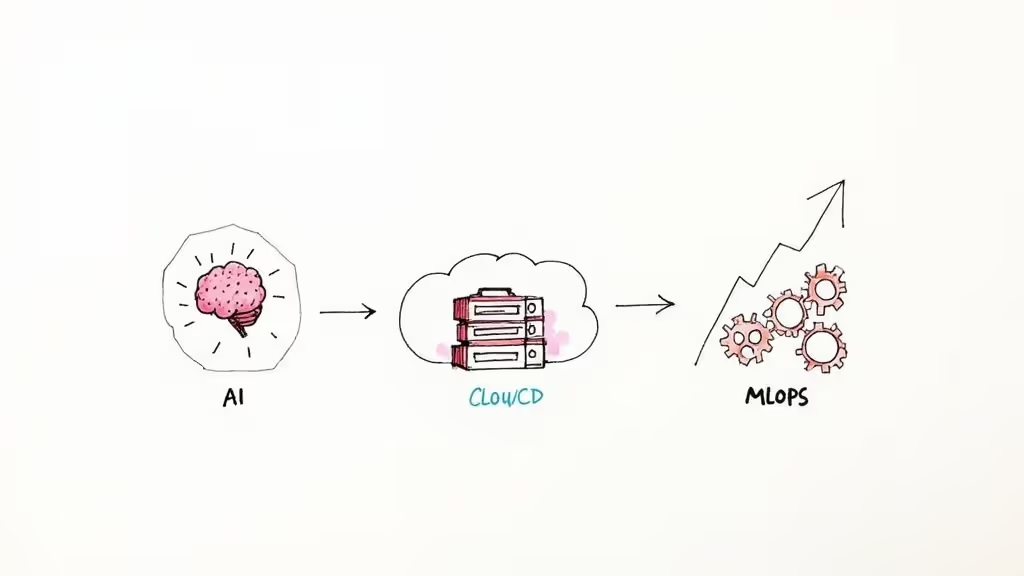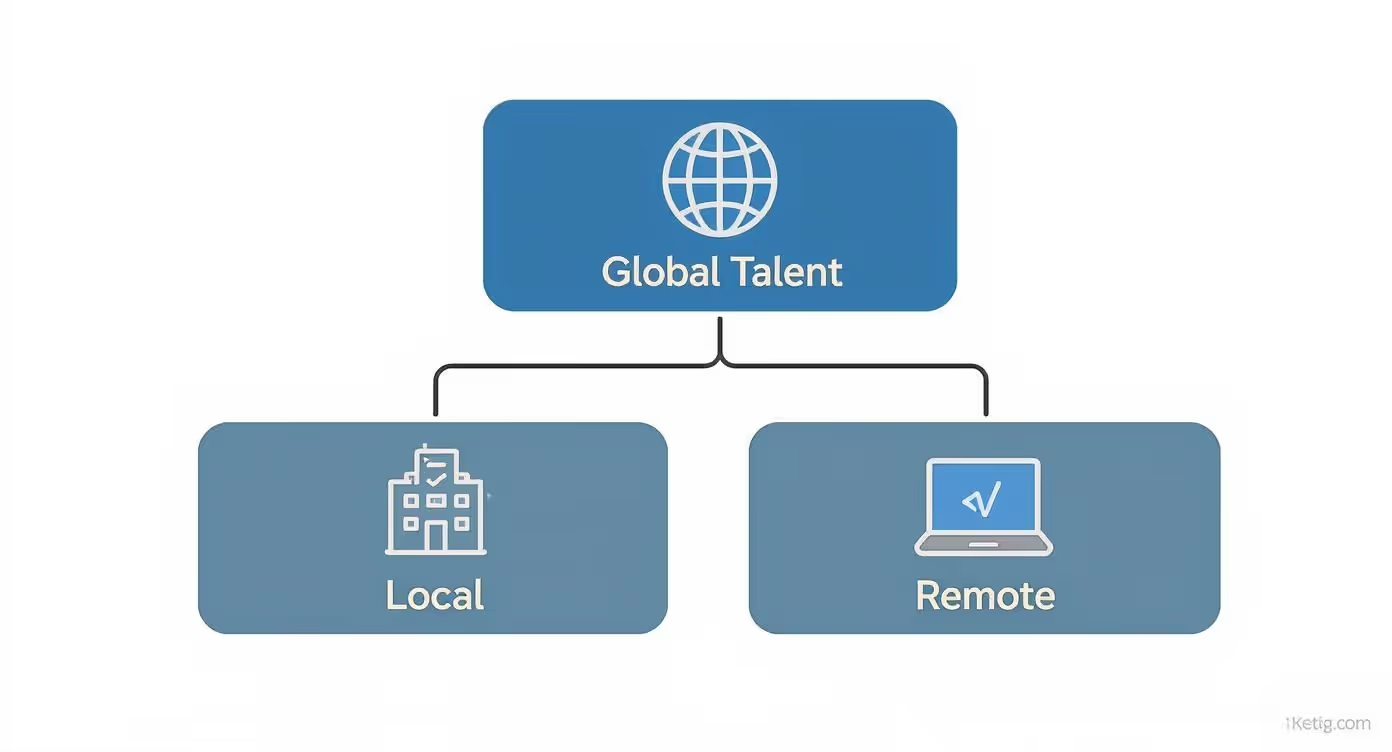TL;DR
- Yes, but demand is for specialists, not generalists. The market is hot for engineers in AI/ML, MLOps, and cloud infrastructure, while generic full-stack roles are cooling.
- AI-related roles are growing 3x faster than the average job. If you're not hiring for AI, you're falling behind.
- Global, remote-first hiring is standard practice. Limiting your search to a local area puts you at a massive competitive disadvantage.
- Your action plan: Audit your current skill gaps, define roles by business impact (e.g., "reduce churn by 10%"), and use pre-vetted talent to hire faster.
Who This Is For
This guide is for technical leaders who need to act fast:
- CTO / Head of Engineering: Deciding where to invest in talent to gain a competitive edge.
- Founder / Product Lead: Scoping roles and setting budgets for new AI features.
- Talent Ops / Hiring Managers: Sourcing and vetting specialized engineers without a 3-month hiring cycle.
Quick Answer: Yes, But the Game Has Changed
alt text: A software engineer working on a laptop with lines of code in the background.
Yes, software engineers are in high demand, but the market now prizes specialization over generalization. The days of easily filled, broad developer roles are over. Today’s demand is for experts in high-growth fields like Artificial Intelligence (AI), cloud infrastructure, and Machine Learning Operations (MLOps).
The need for software engineers hasn't gone away—it has shifted to deeply strategic roles. The real race is to develop proprietary AI models, secure cloud-native architectures, and optimize massive data pipelines. That requires a different kind of engineer.
This focus on specialization ties directly to business impact:
- Faster Time-to-Value: An AI specialist can ship a complex feature like a Retrieval-Augmented Generation (RAG) system in months, not years.
- Reduced Risk: A dedicated cloud security engineer mitigates vulnerabilities that a generalist might miss, protecting customer data.
- Improved Quality & Scalability: An expert in distributed systems ensures your platform handles growth without costly downtime.
Software Engineer Demand Scorecard (2025)
This table breaks down the current market dynamics to help you make informed decisions quickly.
According to the US Bureau of Labor Statistics, software developer roles are projected to add over 327,900 new jobs by 2033. You can explore more data on the software engineering job market to see these trends in action.
The key takeaway is clear: stop asking if software engineers are in demand and start asking which software engineers are in demand.
Practical Examples: The New In-Demand Roles

alt text: Engineers collaborating around a futuristic interface showing neural network diagrams.
While the market for general software roles has tightened, demand for specialists is white-hot. AI-related jobs are expanding over three times faster than the average role. You can dig deeper into the 2025 software engineer job market trends to see the data.
The three most critical, interconnected areas are:
- Artificial Intelligence and Machine Learning (AI/ML): The brain. Engineers who design, train, and fine-tune models that power generative AI copilots and predictive engines.
- Cloud Infrastructure: The horsepower. Platforms like AWS, Azure, and GCP provide the scalable compute AI requires.
- Machine Learning Operations (MLOps): The bridge from experiment to product. MLOps engineers automate how ML models are deployed, monitored, and maintained reliably.
Without MLOps, even a groundbreaking AI model is just a science project stuck on a laptop.
Example 1: SaaS Engineer vs. AI Engineer Skill Matrix
This table contrasts the skills for a traditional SaaS engineer versus a specialized AI/ML engineer. The difference is stark.
Getting this distinction right is the first step toward scoping roles that deliver on your company's goals.
Example 2: Real-World MLOps Interview Question
To find out if an MLOps candidate can do the job, give them a practical scenario.
Question: "Describe the CI/CD pipeline you would build to automate the deployment of a Scikit-learn model committed to a Git repository. What are the key stages, tools, and how would you handle rollback?"
What a great answer includes:
A top-tier candidate will walk through a systematic process showing they think about reliability and automation.
- Trigger: Process starts on a
git pushto the main branch. - Build & Test: Use GitHub Actions to run unit tests, package the model into a Docker container, and push it to a registry.
- Deploy to Staging: Deploy the new container to a Kubernetes staging environment.
- Validate: Run automated integration tests against the staging API to ensure the model behaves as expected.
- Promote to Production: If tests pass, automatically promote the container to production using a blue-green or canary strategy.
- Monitor & Rollback: Use Prometheus and Grafana to monitor performance (latency, error rates). They must mention automated alerts and a rollback plan if key metrics decline.
An answer like this proves they have the hands-on experience to build production-grade ML systems.
Deep Dive: Winning with a Global, Remote-First Strategy
Your next star engineer probably doesn't live down the street. As demand for specialized talent climbs, limiting your search to a local radius is a strategic mistake. Innovation hubs are global, from Eastern Europe to Latin America. Tapping into these markets is a talent-sourcing superpower.
The global software development workforce is expanding. The market is projected to hit $3,567 billion in 2025. You can read more about the growth of the global developer market on springsapps.com.
Adopting a remote-first strategy moves the goalposts from physical proximity to pure proficiency. It allows you to hire the best person for the job, period. Of course, this requires more than just a Zoom subscription. You need new operational skills. For a great overview, see these best practices for mastering virtual hiring for remote employees.
The In-Demand Tech Stack for AI and ML Roles
The lines between AI Engineer, MLOps Engineer, and Data Engineer can be blurry. This table breaks down the core competencies you should be looking for.
Trade-Offs: Local vs. Global Hiring

alt text: Infographic showing that a global talent pool provides access to both local and remote engineers, expanding the available talent.
Choosing to hire globally involves trade-offs.
- Pros: Easier collaboration in the same time zone, simpler compliance.
- Cons: Severely limited talent pool, higher salary competition, slower time-to-hire.
- Pros: Access to a vast, specialized talent pool, significant cost advantages, faster hiring cycles.
- Cons: Requires intentional remote-first processes (async communication, clear documentation), potential time zone challenges.
For most tech companies building specialized products, the benefits of a global talent pool far outweigh the operational overhead.
Checklist: Your 3-Step Action Plan for Hiring Top Engineers
The data is clear: software engineers are in high demand, but only companies hiring with precision are winning. Use this framework to sharpen your strategy.
[ ] Step 1: Audit Your Skill Gaps
Before writing a job description, map your current team's talent against critical roles like AI/ML, MLOps, and cloud infrastructure.
- Pinpoint immediate needs: Can you reliably deploy an AI model and keep it running? If not, an MLOps engineer is a critical gap.
- Look at future projects: Is a proprietary RAG system on your 6-month roadmap? You need an AI specialist with vector database and model fine-tuning experience.
[ ] Step 2: Define the Role by Business Impact
Vague descriptions attract vague candidates. Define success in business terms.
- Instead of: "Write Python code for our ML system."
- Try: "Develop and deploy a predictive model that reduces customer churn by 10% within six months."
This clarity attracts mission-driven talent. A solid guide on how to source candidates can also provide strategies for finding these specialists.
[ ] Step 3: Use a Pre-Vetted Talent Network
The traditional hiring process is slow and risky. Tapping into a pre-vetted network gives you a shortcut to qualified, proven candidates.
- This approach guarantees a baseline of technical and communication skills.
- It cuts down your time-to-hire from months to 2–4 weeks.
- You can explore various engagement models, like those outlined in our guides on nearshore vs offshore outsourcing and IT outsourcing development.
What to Do Next
- Book a 20-minute scoping call to discuss your specific technical needs.
- See sample profiles of our senior, pre-vetted AI and software engineers.
- Start a Pilot with us and have your new team member integrated in as little as 2–4 weeks.
References
- US Bureau of Labor Statistics, Occupational Outlook Handbook for Software Developers.
- LinkedIn, "Software Engineering Job Market Insights 2024".
- Underdog.io, "The 2025 Software Engineer Job Market".
- Springsapps, "How Many Software Engineers Are There in 2025?".
- ThirstySprout, "Hire Remote AI Developers".
Hire from the Top 1% Talent Network
Ready to accelerate your hiring or scale your company with our top-tier technical talent? Let's chat.

